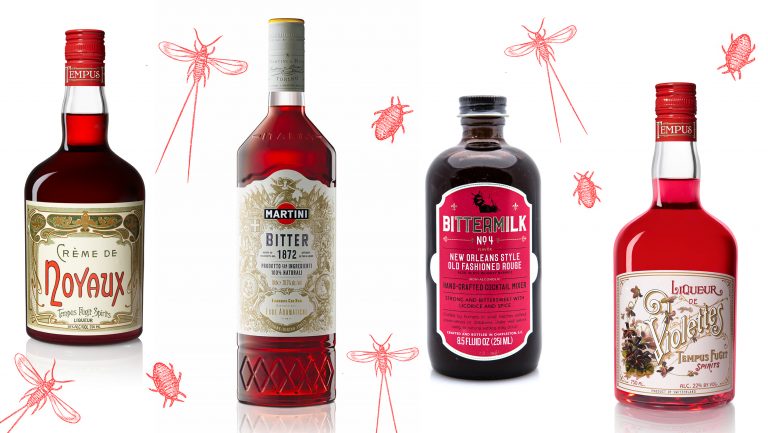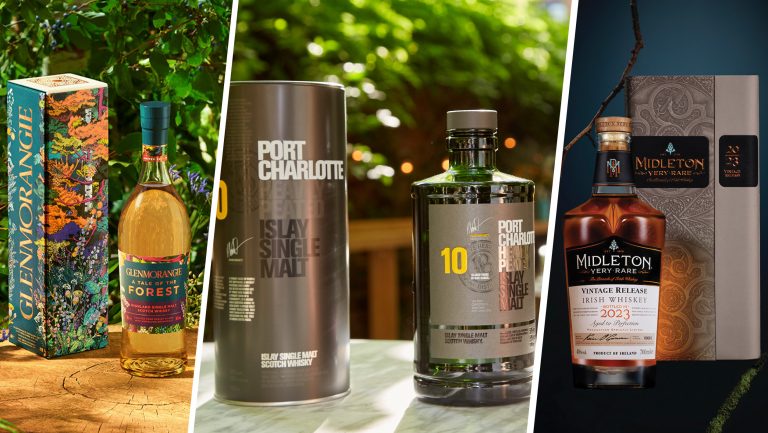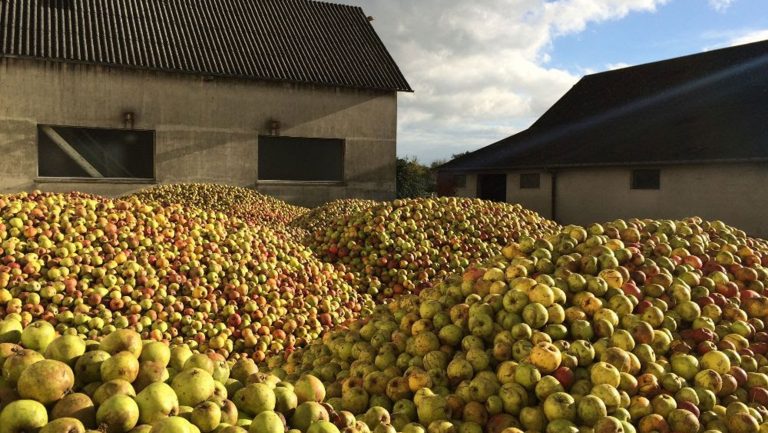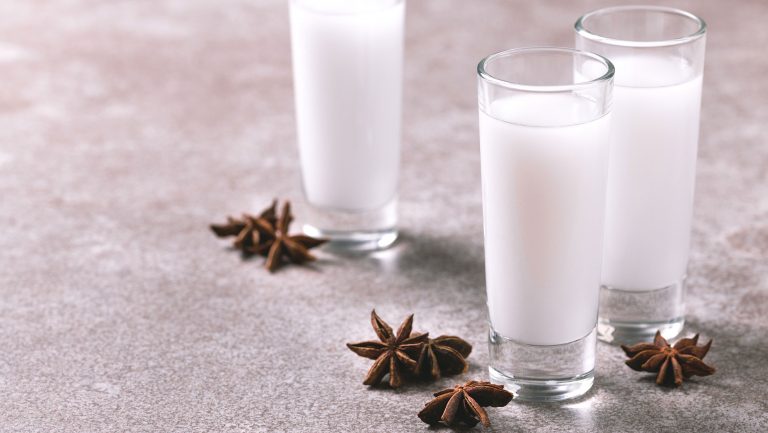A decade after Campari switched out its coloring from insect-derived cochineal to artificial dyes, several producers are now putting the bright bug-based red hue back into products. Here, SevenFifty Daily looks at the new wave of cochineal-colored spirits and mixers. But first, a history lesson.
The History of Red-Colored Spirits
Cochineal is a product of the Americas, but a different set of insects was used to dye fabric as well as one notable drink long before Columbus. Kermes is a coloring that was made from the crushed scale insect Kermes vermilio (and a couple of related bugs), which feeds on the sap of Mediterranean oak trees. The dye was used to color silk, and that silk was infused into a liqueur called alkermes (or alchermes), along with apple juice, rose water, ambergris, gold flakes, crushed pearls, aloe, and other ingredients. This liqueur recipe dates back to at least 800 A.D. when liqueurs and medicine were one and the same.
Today, versions of alkermes liqueur are still produced, specifically to make the traditional Italian red dessert zuppa inglese. These liqueurs are no longer colored with kermes bugs: Some makers use cochineal; others use artificial coloring. It’s doubtful that any still include crushed pearls and gold flakes. And few, if any, are imported into the U.S.

Don’t miss the latest drinks industry news and insights. Sign up for our award-winning newsletters and get insider intel, resources, and trends delivered to your inbox every week.
Cochineal was first encountered by westerners around 1520. It was farmed in South America, in particular in Oaxaca, Mexico, though evidence suggests it was used as far back as 2,000 years ago in Peru. Cochineal, like kermes, is a scale insect, but it lives on the prickly pear cactus rather than Mediterranean oak. The females of the species produce carminic acid, which yields the famous red color when the insects are harvested, dried, and crushed.
Though cochineal took a while to catch on as a fabric dye back in Europe, eventually it was shown that the insects produced more dye per bug, were easier to harvest, and the dye was more colorfast on most fabrics that kermes, according to the history of cochineal in the book “A Perfect Red” by Amy Butler Greenfield.
Like kermes, cochineal made its way into food and beverages (and medicine and cosmetics) and was the most popular red dye until synthetic aniline dyes were created in the last half of the 19th century. These artificial dyes, which were produced from industrial waste and therefore less expensive to make, then became the dominant coloring for almost everything.
In the 1970s, a cancer scare in the United States over the dye FD&C Red No. 2 inspired a return to the use of cochineal for food coloring—cochineal is considered a natural food coloring and can be labeled as such. (Readers of a certain age will remember there was no red M&M’s candy for about 10 years—this was the result of the red food coloring scare.)
Today, cochineal is still used in cosmetics and red-colored foods like yogurt, jams, and dried shrimp. In these products—and in spirits—the coloring is labelled as E120, carmine, cochineal, or sometimes Natural Red 4, according to where in the world the product is being sold.
There are two major downsides to using this bug coloring. The first is that insect ingredients are not considered vegetarian, which is a concern for some consumers. The second is that insect ingredients can cause allergic reactions, particularly in people who are also allergic to shellfish. These reactions have been shown in children, but incidents of cochineal allergies in adults may not be as common. (In 2012, cochineal was the subject of multiple news segments focused on the non-vegetarian nature of cochineal and allergic reactions to it when it was revealed that Starbucks’ Strawberry Frappuccino was colored with it.)
In the spirits world, Campari replaced its cochineal coloring with artificial coloring around 2006; the ingredients labeling on Campari packaging around the world varies according to local laws. (The Swedish government’s alcohol website, however, lists that cochineal coloring (“E120”) is still used in that local formulation.)
Old and New Products with Cochineal
Some older products continue to use cochineal, including Cappelletti, which is a bitter spirit that’s wine-based, and San Pellegrino’s Sanbitter, a non-alcoholic version of Campari and soda.
In recent years, several new products containing cochineal have entered the market. Most of these are Campari alternatives that use “aperitivo” and/or “americano” in their names as an indicator of the bitter spirit they’re imitating; many of these products also rely on a combination of gentian and citrus as the backbone of their flavor. These include St. George Spirits’ Bruto Americano with gentian and California-grown Seville orange, Leopold Bros’ Aperitivo with gentian and grapefruit, and Pur Spirits’ Aperitivo Zamaro, which offers plenty of orange citrus, but purposely avoids gentian in favor of other bittering ingredients. From Buffalo, New York, Lockhouse Ibisco Bitter takes its name from the hibiscus in the mixture, and relies on grapefruit and coriander for its citrus notes, and gentian plus blessed thistle for bittering agents. Unlike the other spirits, Ibisco Bitter is opaque rather than clear. And Martini & Rossi Riserva Speciale Bitter Liqueur was launched at Tales of the Cocktail this year. It contains gentian along with wormwood in keeping with the tradition of the vermouth brand.
Miracle Mile Bitters Company has produced an Aperitivo Bitters, colored with cochineal and described as a “Campari-style aperitivo, tweaked and concentrated down to bitters form.” Don Ciccio e Figli, a Washington, D.C., liqueur producer, offers three products that contain cochineal: Cinque Aperitivo (an Aperol substitute), Luna Amara (a Campari alternative with gentian, grapefruit, and prickly pear), and Amaro Donna Rosa (a “gateway amaro”).
Other spirits using cochineal are not Campari copycats at all. For example, Bittermilk’s No. 4 New Orleans Style Old Fashioned Rouge cocktail mixer is essentially a flavored syrup that turns a glass of whisky into a Sazerac with notes of absinthe and bitters. To mimic the red that Peychaud’s brings (though the Peychaud’s is not colored with it), the syrup contains cochineal.
Tempus Fugit Spirits, a company that recreates vintage absinthe, liqueurs, and bitters, uses cochineal in both its Liqueur de Violettes (to make it purple) and Crème de Noyaux (to make it red). John Troia, co-founder of Tempus Fugit, explains that while the use of cochineal in Violettes liqueur was originally meant to replicate the color and shade of violet flowers, its use in Crème de Noyaux was likely “a tongue-in-cheek reference to a test that was used to determine the presence of arsenic in spirits.” Says Troia, “If the spirit turned red, it meant that there was a high or lethal level of arsenic. By coloring the Noyaux red with cochineal, it [implied] that it might be lethal, which of course it was not. Historically, about 90 percent of the Crèmes de Noyaux were dyed red with cochineal. I suspect that some producer started dyeing their product red and then it just became popular and traditional across the category.”

Dispatch
Sign up for our award-winning newsletter
Don’t miss the latest drinks industry news and insights—delivered to your inbox every week.
Camper English is an international cocktails and spirits writer, speaker, and consultant, with a focus on the science of booze and big clear ice. His work has appeared in Popular Science, Cook’s Science, Whisky Advocate, Saveur, Details, the San Francisco Chronicle, and many other publications.







